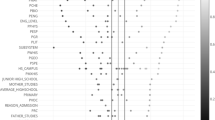Abstract
In recent years, business schools face a common problem of selecting quality students for their Master of Business Administration (MBA) programs so that the target placement percentage is achieved. Selecting a wrong student may increase the number of unplaced students. Also, more the number of unplaced students more is the negative impact on the institute’s reputation. Business school authorities would therefore always want to ensure that they admit the right set of students to their MBA program. In this article, we used supervised learning techniques to model and select the optimal academic characteristics of students to enhance their placement probability. We propose a novel hybrid model based on classification tree (CT) and artificial neural network (ANN) which we call as hybrid CT–ANN model, to analyse business school data. A comparative study of various supervised models with our proposed model using different performance measures is also presented. Our finding shows that the proposed hybrid CT–ANN model achieves greater accuracy in predicting students’ placement than conventional supervised learning models.






Similar content being viewed by others
References
Ojha, A.K.: Management education in India: avoiding the simulacra effect. In: Management Education in India, pp. 55–77. Springer, New York (2017)
Ganatra, D., Dinesh Kumar, U.: A dean’s dilemma: selection of students for the MBA program. Harv. Bus. Rev. 1–6 (2014)
Asif, R., Merceron, A., Ali, S.A., Haider, N.G.: Analyzing undergraduate students’ performance using educational data mining. Comput. Educ. 113: 177–194 (2017)
Pena-Ayala, A.: Educational data mining: a survey and a data mining-based analysis of recent works. Expert Syst. Appl. 41(4), 1432–1462 (2014)
Romero, C., Ventura, S.: Educational data mining: a review of the state of the art. IEEE Trans. Syst. Man Cybern. C 40(6), 601–618 (2010)
Meedech, P., Iam-On, N., Boongoen, T.: Prediction of student dropout using personal profile and data mining approach. In: Intelligent and Evolutionary Systems, pp. 143–155. Springer, New York (2016)
Yadav, S.K., Pal, S.: Data mining application in enrollment management: a case study. Int. J. Comput. Appl. 41(5), 1–6 (2012)
Kovacic, Z.: Early prediction of student success: mining students’ enrolment data. In: Proceedings of Informing Science and IT Education Conference (InSITE), pp. 648–665 (2010)
El Moucary, C.: Data mining for engineering schools predicting students performance and enrollment in masters programs. Int. J. Adv. Comput. Sci. Appl. 2(10), 1–9 (2011)
Gupta, S.K., Gupta, S., Vijay, R.: Prediction of student success that are going to enroll in the higher technical education. Int. J. Comput. Sci. Eng. Inf. Technol. Res. 3(1), 95–108 (2013)
Sirat, J., Nadal, J.: Neural trees: a new tool for classification. Netw. Comput. Neural Syst. 1(4), 423–438 (1990)
Sakar, A., Mammone, R.J.: Growing and pruning neural tree networks. IEEE Trans. Comput. 42(3), 291–299 (1993)
Sethi, I.K.: Entropy nets: from decision trees to neural networks. Proc. IEEE 78(10), 1605–1613 (1990)
Tsujino, K., Nishida, S.: Implementation and refinement of decision trees using neural networks for hybrid knowledge acquisition. Artif. Intell. Eng. 9(4), 265–276 (1995)
Foresti, G.L., Dolso, T.: An adaptive high-order neural tree for pattern recognition. IEEE Trans. Syst. Man Cybern. B 34(2), 988–996 (2004)
Chen, Y., Abraham, A., Yang, J.: Feature selection and intrusion detection using hybrid flexible neural tree. Adv. Neural Netw. ISNN 2005, 980–980 (2005)
Chen, Y., Yang, B., Meng, Q.: Small-time scale network traffic prediction based on flexible neural tree. Appl. Soft Comput. 12(1), 274–279 (2012)
Bouaziz, S., Dhahri, H., Alimi, A.M., Abraham, A.: A hybrid learning algorithm for evolving flexible beta basis function neural tree model. Neurocomputing 117, 107–117 (2013)
Tsai, C.C., Lu, M.C., Wei, C.C.: Decision tree-based classifier combined with neural-based predictor for water-stage forecasts in a river basin during typhoons: a case study in taiwan. Environ. Eng. Sci. 29(2), 108–116 (2012)
Fong, S., Si, Y.W., Biuk-Aghai, R.P.: Applying a hybrid model of neural network and decision tree classifier for predicting university admission. In: 7th International Conference on Information, Communications and Signal Processing, pp. 1–5 (2009)
Ragab, A.H.M., Mashat, A.F.S., Khedra, A.M.: Hrspca: Hybrid recommender system for predicting college admission. In: 12th International Conference on Intelligent Systems Design and Applications (ISDA), pp. 107–113 (2012)
Pan, Z.S., Chen, S.C., Hu, G.B., Zhang, D.Q.: Hybrid neural network and c4.5 for misuse detection. In: International Conference on Machine Learning and Cybernetics, vol. 4, pp. 2463–2467 (2003)
Mathiyazhagan, K., Sudhakar, S., Bhalotia, A.: Modeling the criteria for selection of suppliers towards green aspect: a case in Indian automobile industry. In: OPSEARCH, pp. 1–20 (2017)
Kim, K.: A hybrid classification algorithm by subspace partitioning through semi-supervised decision tree. Pattern Recogn. 60, 157–163 (2016)
Murthy, S.K.: Automatic construction of decision trees from data: A multi-disciplinary survey. Data Min. Knowl. Discov. 2(4), 345–389 (1998)
Zhou, Z.H., Wu, J., Tang, W.: Ensembling neural networks: many could be better than all. Artif. Intell. 137(1–2), 239–263 (2002)
Cover, T.M.: Geometrical and statistical properties of systems of linear inequalities with applications in pattern recognition. IEEE Trans. Electron. Comput. EC–14(3), 326–334 (1965)
Lee, D.S., Srihari, S.N.: A theory of classifier combination: the neural network approach. In: Proceedings of the Third International Conference on Document Analysis and Recognition, vol. 1, pp. 42–45 (1995)
Rumelhart, D.E., Hinton, G.E., Williams, R.J.: Learning internal representations by error propagation. Technical report, California University, San Diego, La Jolla, Institute for Cognitive Science, pp. 318–362 (1985)
Davis, J., Goadrich, M.: The relationship between precision-recall and roc curves. In: Proceedings of the 23rd International Conference on Machine learning, ACM, pp. 233–240 (2006)
Acknowledgements
The authors acknowledge the concerned editor and reviewers for their constructive comments. The authors also like to thank Prof. U. Dinesh Kumar and Dr. Dhimant Ganatra of Indian Institute of Management, Bangalore for making the data available. The authors gratefully acknowledge the financial assistance received from Indian Statistical Institute (I.S.I.) and Visvesvaraya Ph.D. Scheme awarded by the Government of India.
Author information
Authors and Affiliations
Corresponding author
Rights and permissions
About this article
Cite this article
Chakraborty, T., Chattopadhyay, S. & Chakraborty, A.K. A novel hybridization of classification trees and artificial neural networks for selection of students in a business school. OPSEARCH 55, 434–446 (2018). https://doi.org/10.1007/s12597-017-0329-2
Accepted:
Published:
Issue Date:
DOI: https://doi.org/10.1007/s12597-017-0329-2




